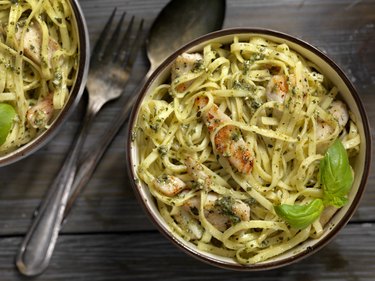
Cooking pasta may seem like one of the simplest tasks in the kitchen. But the taste of your pasta may improve if you add a few easy steps of preparation and learn the best way to store pasta. Cooking pasta ahead of time and reheating it can also be a great way to prep meals.
Boil Your Pasta
Video of the Day
Pasta, along with rice, bread, cheese and sweets, is often one of the first foods to get slashed from your diet when you're embarking on a weight loss journey. But it turns out that carbs like pasta can actually be good for you if you're choosing the right kind and preparing it well. Plus, learning the best ways of storing cooked pasta can help you plan healthier meals for the week.
Video of the Day
While regular pasta (which is typically made from refined flours) can be part of a healthy diet if eaten in moderation — such as being incorporated into the Mediterranean diet — whole wheat pasta is really where the health benefits lie. That's because whole wheat pasta is high in fiber, protein, magnesium and zinc.
Start by pouring water into a big pot. While many pasta boxes suggest you cook your pasta in 4 to 6 quarts of water, you may be able to get away with less. Academia Barilla, meanwhile, says that one liter of water for every 100 grams of pasta is ideal.
Next, you'll want to throw in a good amount of salt. Tossing at least two tablespoons of salt into your pot of water, making a sort of sea water mix, will help bring some flavor to your pasta while it's boiling. This way, you won't have to salt as much afterward.
Bring the water to a full boil. Pour your pasta into the water, and you'll see that the boil will slow down as the pasta cools the water initially. The water will, however, eventually come back up to a full boil, and you'll want to stir occasionally to prevent the pasta from sticking.
How long you boil your pasta depends on the size and type of pasta. Fresh pasta, for example, will take a lot less time to boil — and is a bit trickier to time. Dried pasta can take seven to 10 minutes of boiling before it's ready.
Once it's starting to get soft, you can take a piece out with a spoon, wait for it to cool, then taste to see if it's ready. You'll want your pasta to be soft, but not too mushy, and a bit chewy when bitten. This is what it means to cook your pasta al dente — the Italian term which literally means "to the tooth."
Drain It, Toss It, Serve
Before you drain your pasta, scoop out a cup of water from your pot and place it to the side. This starchy water can surprisingly be a great little addition to your pasta recipes, as mixing it with sauces or stirring it into pasta on a pan can add flavor.
Next, drain your pasta in a strainer, then pour the pasta back into your pot or a clean pan, depending on what dish you're making. If you like simple pasta dishes as a side to your meat or vegetables, simply add in a little bit of butter, olive oil, salt, pepper and garlic into the pot and stir. Serve in a bowl or plate, and sprinkle it with Parmesan cheese.
If you want to try a more specific pasta dish, like cacio e pepe ("cheese and pepper"), you can try tossing it on a pan. In your pan, melt butter with crushed pepper for about a minute. Add half your cup of saved pasta water and bring it to a simmer, then throw in your pasta and butter. Stir the pasta on low heat.
Once everything is mixed together, take the pan off the heat and throw in Pecorino cheese, stirring it into the pasta until it's melted. Serve the pasta hot. This is one great way of cooking pasta ahead of time and reheating it later.
Storing Cooked Pasta
You'll often make a great pasta dish, forget how filling it can be and have a large amount leftover. Instead of throwing it out that night, why not save it for the next few nights? Cooking pasta ahead of time and reheating it later can help you save time on a busy schedule. Storing cooked pasta can also help you save money by not wasting leftovers.
The best way to store pasta is in airtight containers in the fridge. Make sure to eat the pasta within two to five days. When preparing leftovers, heat them completely in the microwave or on the stove before eating.
Another helpful tip may be to store your pasta and sauce separately. If you've made a red meat sauce for your pasta, for example, store it in a separate container rather than mixing it all together. According to Barilla, however, it may also be good to add a bit of olive oil into your plain pasta before storing, to help avoid clumping.
The best way to store pasta for a long period of time is to pack it into zip-close bags and freeze it. Storing cooked pasta in the freezer will keep your pasta good for several weeks and even up to a few months. This way, when you're home after a long day at work, you can simply unfreeze and reheat.